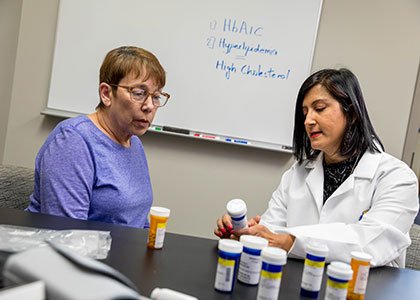
- Educate you on basic information in a variety of conditions/diseases, such as:
- Diabetes;
- High blood pressure;
- High cholesterol; and
- Heart and vascular disease.
- Provide you with counseling on the purpose of a medication, proper use of a medication and other information that you may want to know (for example, side effects to watch out for).
- Identify potential medication problems that may happen (e.g., drug-disease interactions).
- Provide tips on lifestyle adjustments and alternative nonmedication advice.
- You can have your questions answered and be provided a better understanding of your medication use and disease management.
- Pharmacists can help you prevent potential medication problems and reduce visits to acute care.
- You can increase adherence to medication therapy.
- You can know more about managing your disease state and lifestyle changes to decrease risk factors.
- You can improve your health conditions.
- National Diabetes Prevention Program (NDPP) focuses on helping people with prediabetes and Type 2 diabetes in the United States.
- The program focuses on lifestyle changes such as healthy eating and physical activity.
- You can find NDPP sites in South Dakota such as Yankton, Platte, Aberdeen, Rapid City, Sioux Falls and Spearfish.1
- Diabetes Self-Management Education (DSME) supports you with the knowledge, skill and ability necessary for diabetes self-care.1
- You can find locations that offer DSME throughout South Dakota:
- Southwest S.D.: Custer, Rapid City, Deadwood, Rosebud.
- Southeast S.D.: Canton, Vermillion, Viborg, Mitchell, Madison, Wagner, Platte, Sioux Falls.
- Northeast S.D.: Aberdeen, Mobridge, Brookings, Pierre, Clear Lake.
- Northwest S.D.: Spearfish, Sturgis.2
- You can find locations that offer DSME throughout South Dakota:
More information about NDPP and DSME can be found at the South Dakota Department of Health website.
Pharmacists can also educate you on reducing the risk of heart disease and stroke. Risk factors and ways to reduce your risk that you can discuss with your pharmacist include:
- Smoking and tobacco use,
- High blood pressure,
- High cholesterol,
- Diabetes,
- Being overweight and
- Exercising.
- By controlling these risk factors, you can decrease your risk of having heart disease, a heart attack or a stroke.
Talk to your pharmacist to learn more about what classes are offered at your pharmacy or in your area.
More information on cardiovascular disease (CVD) risk factors and education on controlling risks can be found by visiting the South Dakota Department of Health website.
- If you want to keep your blood pressure down, pharmacists can provide tips to achieve your goal.
- This might include talking about basic exercise techniques, how to limit the salt you eat, relaxation techniques and help with quitting smoking.
- Pharmacists can explain potential medication problems that could worsen blood pressure and can provide alternative medication suggestions when needed.
- Pharmacists can discuss alternative food options to help keep blood sugar down.
- This may include things such as low-sugar ice cream products, nonsugar sweeteners and other healthy alternatives.
- Pharmacists can talk to you about why it is important to control cholesterol and may be able to help optimize medications used to treat cholesterol.
- Pharmacists can help you select a blood pressure monitor for your home or can check your blood pressure at the pharmacy.
- Pharmacists can assist you in stopping use of tobacco products by creating a plan based on your needs.
References:
(1) Adapted from S.D. Department of Health Diabetes Education
(2) Adapted from S.D. Diabetes Coalition
(3) Adapted from S.D. Department of Health Heart Disease

